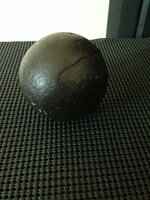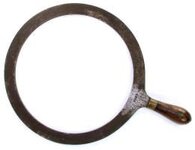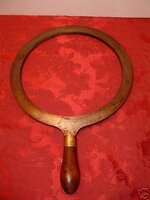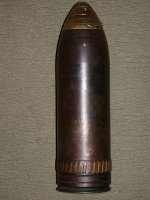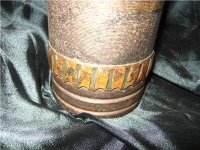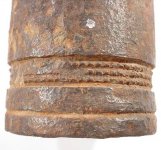Navigation
Install the app
How to install the app on iOS
Follow along with the video below to see how to install our site as a web app on your home screen.
Note: This feature may not be available in some browsers.
More options
You are using an out of date browser. It may not display this or other websites correctly.
You should upgrade or use an alternative browser.
You should upgrade or use an alternative browser.
Cannon ball
- Thread starter Chunga
- Start date
YukonCorn
Sr. Member
- Jun 13, 2013
- 405
- 21
- Detector(s) used
- Garrett AT Pro, Garrett Pro-pointer, Plastic Scooper, Trowel, 17" Shovel, Lesche Digging Tool, Garrett Camo Treasure Pouch, Garrett Detector Bag, Headphone Bag, LED Flashlight, 8.5"x11" DD Coil Cover
- Primary Interest:
- All Treasure Hunting
Cool ball!
NC field hunter
Silver Member
- Jul 29, 2012
- 4,227
- 1,626
Nice find. A friend of mine found one metal detecting about 15 years ago. He walked back to the truck happy as a lark. Everyone else ran from him. Come to find out, it was still a live explosive. He put it back in the hole in which he dug it from. I wish someone would chime in and tell me how such a situation should be handled.
d2
Bronze Member
- Mar 18, 2005
- 1,515
- 981
- Detector(s) used
- Tesoro/Cibola Garrett ATPro
- Primary Interest:
- Relic Hunting
Old Civil War artillery is very easy to disarm and better yet there are a lot of folks, probably in NC, that know how and would do it. I wish I knew where he put it. If it was solid there is no reason to woory because it isnt the explosive type. Has to have a fuze in it to have contained black powder and they are easy to see...d2
Thommy
Full Member
- Mar 12, 2012
- 190
- 73
- Detector(s) used
- Tesoro Vaquero, Garrett Pro-Pointer, Nautilus MF, Fisher 1266, Heathkit
- Primary Interest:
- Relic Hunting
PERCUSSION FUSES OF THE CIVIL WAR ERA will be inert after 150 years, but a hot drill bit will set them off. I've found many live shells. No need to freak out on them, like they were WW1 or WW2 shells. Just, do not set them next to the fireplace. Often, you can push a water-pik nozzle down through the fuze plug opening and rinse all the old black powder out. There are people who dis-arm these. NEVER TRY TO DRILL INTO A SHELL.
Jason in Enid
Gold Member
- Oct 10, 2009
- 9,581
- 9,202
- Primary Interest:
- All Treasure Hunting
..... Everyone else ran from him. Come to find out, it was still a live explosive. He put it back in the hole in which he dug it from. I wish someone would chime in and tell me how such a situation should be handled.
Well, if you are worried, rule number one is to not let it dry out. A simple transport solution would be to put it in an ice chest willed with water. It will keep it wet, keep oxygen from over-rusting the exterior, and provided shock isolation (can't bounce around) during travel.
TheCannonballGuy
Gold Member
- Feb 24, 2006
- 6,596
- 13,378
- Detector(s) used
- White's 6000, Nautilus DMC-1, Minelab
- Primary Interest:
- Relic Hunting
Your photo shows the ball is not a "perfect sphere" -- it is out-of-round, like a tomato or an orange. Unfortunately, that means it is absolutely not a cannonball. ALL cannonballs had to be very carefully manufactured to be perfectly-round, so they would not jam inside the cannon's barrel during firing -- which could cause the cannon itself to burst. So, the Army and Navy Ordnance Department had Inspectors, whose job was to use a ring-gauge to check every cannonball for perfect roundness (and exact size) before the ball was issued to the artillerymen. Any "lumpiness" would make the ball be rejected by the Ordnance Inspector, and be sent back to the foundry to be melted down and re-cast. See the photos of 1860s cannonball ring-gauges, below.
Note that the ring-gauge's center is a PERFECT circle. Placing it around the ball and rolling the ball would detect any out-of-roundness or "bumps" on the ball's surface.
If you want proof of what I'm telling you, check the photos of cannonballs at civil war artillery websites. You'll see that each and every cannonball is a "perfect sphere."
Ridgeway Civil War collection Artillery shells, Smoothbore balls (both sides)
also:
www.civilwarartillery.com
Note that the ring-gauge's center is a PERFECT circle. Placing it around the ball and rolling the ball would detect any out-of-roundness or "bumps" on the ball's surface.
If you want proof of what I'm telling you, check the photos of cannonballs at civil war artillery websites. You'll see that each and every cannonball is a "perfect sphere."
Ridgeway Civil War collection Artillery shells, Smoothbore balls (both sides)
also:
www.civilwarartillery.com
Attachments
Last edited:
TheCannonballGuy
Gold Member
- Feb 24, 2006
- 6,596
- 13,378
- Detector(s) used
- White's 6000, Nautilus DMC-1, Minelab
- Primary Interest:
- Relic Hunting
NC Field Hunter wrote:
> A friend of mine found one metal detecting about 15 years ago.
> He walked back to the truck happy as a lark. Everyone else ran from him.
> Come to find out, it was still a live explosive.
> I wish someone would chime in and tell me how such a situation should be handled.
The answer to your question very much depends on the time-period of the artillery projectile.
I'm speaking as a Professional Deactivator of PRE-20TH-CENTURY artillery projectiles, who has been doing that work for nearly 40 years. The US National Park Service has used me to "make safe" the civil war shells they find at their battlefiled parks.
I've done extensive research on the subject you're asking about. Relic-hunters have dug more than 100,000 civil war and earlier artillery projectiles... and nearly every one of those projectiles got hit by the shovel during the digging-up process. But, there seems to be not even a single newspaper-report of any of the 100,000+ EXCAVATED civil war or earlier artillery projectiles exploding from being hit with the shovel, or from simply being dropped.
In all the years since approximately 1900, only two people have been killed by civil-war-or-earlier shells... and both of those people were using a power-tool (electric drill or grinder) on the shell when it exploded. There seems to be NO evidence that simply digging or dropping a civil-war-or-earlier shell is dangerous -- even after 100,000+ examples.
That being said, there's plenty of evidence that 20th-Century artillery shells can still be dangerous to drop.
Here's how to tell the difference between a civil-war-or-earlier shell and an 1880s-or-later shell:
1- All cannonBALLS are pre-20th-Century (except for modernday Reproductions).
2- 1880s-&-later "bullet-shaped" artillery projectiles have a copper/brass ring or band which is located 1/2-inch-to-1-inch (or a bit higher) ABOVE the projectile's flat base. Note, sometimes a fired one will be missing its copper/brass ring or band. But NO 1870s-&-earlier artillery shells had a copper/brass ring or band located a little bit ABOVE the projectile's flat base.
Here are photos showing the copper/brass ring or band located a bit ABOVE the projectile's flat base. Note, the ridges on it mean it has been fired. Unfired ones don't have ridges on the copper/brass ring or band. Another photo shows what one looks lke when the ring/band is missing. If the "lower" section of a shell you've found doesn't look like what you see in these photos, it is a pre-1880s artillery projectile.
If you are uncertain about the time-period of an artillery projectile you've found (or own), post closeup photos of it in TreasureNet's "What-Is-It" forum, where I answer identification and time-period questions.
> A friend of mine found one metal detecting about 15 years ago.
> He walked back to the truck happy as a lark. Everyone else ran from him.
> Come to find out, it was still a live explosive.
> I wish someone would chime in and tell me how such a situation should be handled.
The answer to your question very much depends on the time-period of the artillery projectile.
I'm speaking as a Professional Deactivator of PRE-20TH-CENTURY artillery projectiles, who has been doing that work for nearly 40 years. The US National Park Service has used me to "make safe" the civil war shells they find at their battlefiled parks.
I've done extensive research on the subject you're asking about. Relic-hunters have dug more than 100,000 civil war and earlier artillery projectiles... and nearly every one of those projectiles got hit by the shovel during the digging-up process. But, there seems to be not even a single newspaper-report of any of the 100,000+ EXCAVATED civil war or earlier artillery projectiles exploding from being hit with the shovel, or from simply being dropped.
In all the years since approximately 1900, only two people have been killed by civil-war-or-earlier shells... and both of those people were using a power-tool (electric drill or grinder) on the shell when it exploded. There seems to be NO evidence that simply digging or dropping a civil-war-or-earlier shell is dangerous -- even after 100,000+ examples.
That being said, there's plenty of evidence that 20th-Century artillery shells can still be dangerous to drop.
Here's how to tell the difference between a civil-war-or-earlier shell and an 1880s-or-later shell:
1- All cannonBALLS are pre-20th-Century (except for modernday Reproductions).
2- 1880s-&-later "bullet-shaped" artillery projectiles have a copper/brass ring or band which is located 1/2-inch-to-1-inch (or a bit higher) ABOVE the projectile's flat base. Note, sometimes a fired one will be missing its copper/brass ring or band. But NO 1870s-&-earlier artillery shells had a copper/brass ring or band located a little bit ABOVE the projectile's flat base.
Here are photos showing the copper/brass ring or band located a bit ABOVE the projectile's flat base. Note, the ridges on it mean it has been fired. Unfired ones don't have ridges on the copper/brass ring or band. Another photo shows what one looks lke when the ring/band is missing. If the "lower" section of a shell you've found doesn't look like what you see in these photos, it is a pre-1880s artillery projectile.
If you are uncertain about the time-period of an artillery projectile you've found (or own), post closeup photos of it in TreasureNet's "What-Is-It" forum, where I answer identification and time-period questions.
Attachments
Last edited:
gsxraddict
Hero Member
- Sep 21, 2005
- 629
- 413
- Detector(s) used
- XP Deus, Minelab Equinox 800, Whites V3i
- Primary Interest:
- Relic Hunting
Nice find. A friend of mine found one metal detecting about 15 years ago. He walked back to the truck happy as a lark. Everyone else ran from him. Come to find out, it was still a live explosive. He put it back in the hole in which he dug it from. I wish someone would chime in and tell me how such a situation should be handled.
I hope it's not still in the hole? Go get it before a bulldozer does and save some history.
Don't worry about it, the ones that are the most dangerous have the naval fuses, most shells you find these days are generally safe.
Solid shots safe, shells with wooden fuses are safe, if it's a shell with a brass fuse that is intact and wasn't damaged, then you can always take it to a dealer and they will know someone who will disarm it for peace of mind.
I have a monster of a shell from the Yorktown campaign. Something like 13" in diameter but I haven't measured it recently. It was from one of the French double fired mortars. A bunch of the shells (from what I was told a zillion years ago) were dumped in a river in Virginia and weren't recovered till the 1980's or so. The wooden fuse was long gone, but I could still wash a little black powder residue out of the sucker. It lives in the basement. Took everything I had to wrestle It out of the car and roll in where I wanted it. I've always meant to get one of the 9" shells, but haven't gotten around to it.
Top Member Reactions
-
 3540
3540 -
 2084
2084 -
 2062
2062 -
 1163
1163 -
 1116
1116 -
 928
928 -
 850
850 -
 823
823 -
 818
818 -
 782
782 -
 770
770 -
 548
548 -
 531
531 -
 453
453 -
 452
452 -
 446
446 -
E
424
-
 413
413 -
 408
408 -
 404
404
Users who are viewing this thread
Total: 2 (members: 0, guests: 2)


